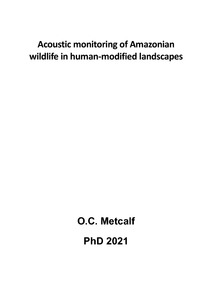Metcalf, Oliver C. (2021) Acoustic monitoring of Amazonian wildlife in human-modified landscapes. Doctoral thesis (PhD), Manchester Metropolitan University.
![[img]](https://e-space.mmu.ac.uk/628175/1.hassmallThumbnailVersion/Post_VIVA_Acoustic%20monitoring%20of%20Amazonian%20wildlife%20in%20human%20modified%20landscapes_Thesis_OM_040521.pdf)
|
Available under License Creative Commons Attribution Non-commercial No Derivatives. Download (10MB) | Preview |
Abstract
Tropical forest covers just 12% of the planet’s land surface, but disproportionately host the planet’s biodiversity, including around two thirds of all terrestrial species. Amazonia retains the largest extent of remaining tropical forest globally, but just over 50% of all tropical forest loss since 2002 has been in the region. Deforestation and disturbance result in significant loss in forest biodiversity, but quantifying the exact nature of those changes can be complex. The Amazon represents a particularly challenging case in which to assess biodiversity change due to the spatiotemporal scales being assessed, because of the high proportion of rare species, and the challenging conditions for conducting biodiversity surveys in tropical forest. Ecoacoustics has been championed as a valuable tool to overcome the difficulties of monitoring in such conditions and at large spatio-temporal scales, but applied analytical methods often remain underdeveloped. In this this thesis I develop and use a range of ecoacoustic methods to help understand the impact of anthropogenic disturbance on Amazonian wildlife, using an extensive audio dataset collected from survey points spanning a degradation gradient in the Eastern Brazilian Amazon. In Chapter 2 I introduce a quick and simple method for the detection of rainfall, tested for efficacy globally and with an accompanying R package. In Chapter 3 I present a new approach to subsampling of acoustic data for manual assessment of avian biodiversity, finding that using a high number of short repeat samples can detect approximately 50% higher alpha diversity than more commonly used approaches. In Chapter 4 I assess the sensitivity and fidelity of two commonly used acoustic indices to biodiversity responses to forest disturbances, finding that measuring indices at narrower, ecologically appropriate time-frequency bins avoids problems with signal masking. In Chapter 5 I use a two-stage, random forest based method to build a multi-taxa classifier for the nocturnal avifaunal community in the study region, and use the classifier-derived data to reveal that the nocturnal bird community is largely robust to less intense forms of forest disturbance. Overall, in this thesis I demonstrate that ecoacoustics can be a highly effective method for inventorying and monitoring biodiversity in one of the most diverse and challenging regions on the planet.
Impact and Reach
Statistics
Additional statistics for this dataset are available via IRStats2.



